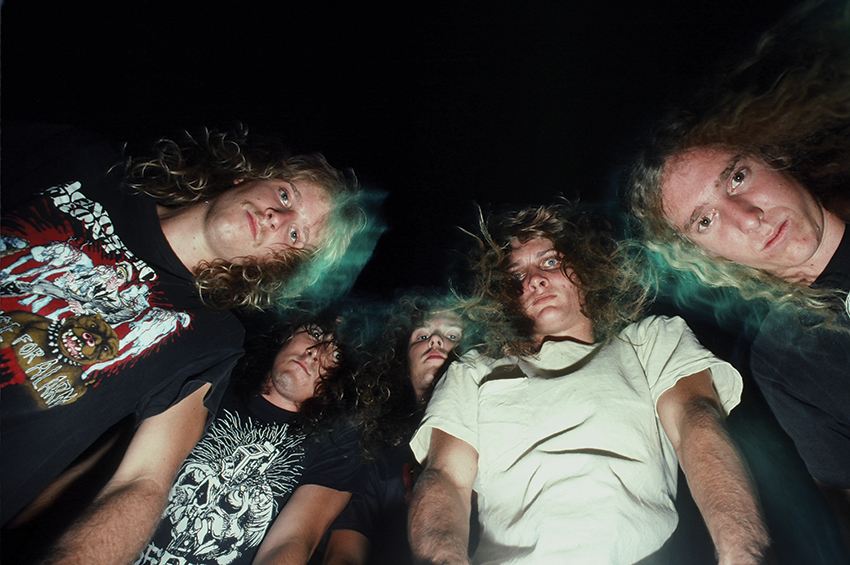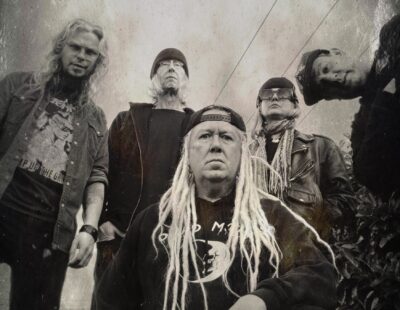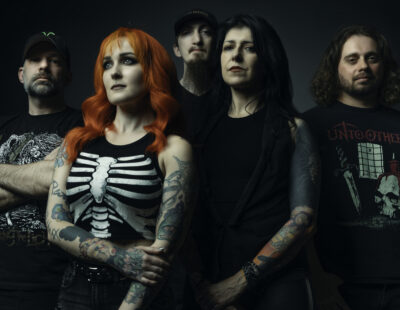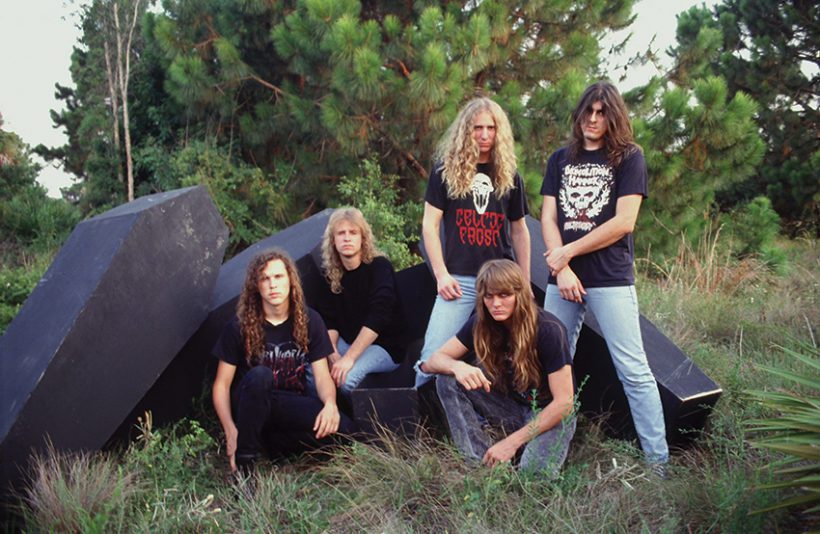
Obituary will perform their seminal death metal classic, Cause of Death, in its entirety at Decibel Metal & Beer Fest: Philly on Saturday, April 13. Tickets for the exclusive performance are still available, but moving fast—fewer than 150 “Metal & Beer” tickets remain. In the time between acquiring tickets and waiting for the Floridian death metal legends to hop the Fillmore in half, you can now dig into the full Cause of Death Hall of Fame from May 2007 and previously unavailable online, featuring interviews with every member of Obituary who performed on the record.
Story by Kory Grow
Guttural incoherence + wild solos = DM classic
When Obituary’s 1989 debut, Slowly We Rot, infected record stores, death metal had never sounded so guttural and primal. Having only previously released a few songs on demos and comps under the names Executioner and Xecutioner, the group fulfilled the potential Roadrunner A&R Monte Conner had seen in them with their debut. John Tardy’s bass-heavy, nonsensical lyrics—kind of a collage of grunts and occasionally coherent horrific-sounding words—combined with the rest of the Tampa-area band’s relentless, pounding riffs had taken what fellow Floridians Death had released two years earlier on their debut and mixed it with a near-European Hellhammer-like delivery. Without even touring, the band—then comprising singer John, drummer Donald Tardy, lead guitarist Allen West, rhythm guitarist Trevor Peres and bassist Daniel Tucker—inspired reverent chatter among death metal’s burgeoning literati. All this, and they’d only just graduated high school.
After Roadrunner asked them to record a follow-up, 1990’s unfuckwithable Cause of Death, everything changed. Bassist Tucker disappeared, found months later as a victim of partial amnesia from a car crash. In the meantime, Obituary drafted new bassist Frank Watkins, who quickly learned the group’s repertoire, and would play on every album since (up to 2009’s Darkest Day. Watkins died of cancer in 2015). Soon after, guitarist Allen West left the band to pursue family life, prompting the group to enlist ex-Death member James Murphy, who’d later become recognized as the closest thing death metal had to a guitar hero. When Obituary finally entered Tampa’s Morrisound Recording to work with producer Scott Burns, they had no idea they’d leave with a death metal masterpiece.
TURNED INSIDE OUT
What stands out to you about the time between Slowly We Rot and Cause of Death?
Donald Tardy: That’s all when it started moving quickly. We were 20 years old, and I was allowed to go write more music and write another album. Slowly was where we just basically learned what we were doing and kind of became the band that we were, but Cause of Death was a true focus on writing an album. It was an exciting time.
What do you remember about Daniel Tucker disappearing?
Donald Tardy: I don’t know. I honestly don’t know. It was probably more confusing for band members than most people around Brandon, or around Tampa, FL, because we never really looked for him.
John Tardy: [Laughs] He wasn’t in the band for very long. He really was just with us long enough. I don’t think we even got the copies of [Slowly We Rot] before he just disappeared.
Trevor Peres: Daniel was a friend of mine. At a party or two I’d jammed with him just for fun or whatever. So I called him up and he came in, learned the songs, played on the album and he played a couple shows with us locally and he just kind of vanished.
Frank Watkins: I actually met Daniel like in 1997 or 1996 at a show in Tampa, and he just walked up to me like, “Hey, what’s happening? I’m Daniel Tucker.” And when he said that, the name was familiar, but it didn’t click. That sounds so familiar, Daniel Tucker? I go, “And you are?” And he goes, “Oh, I’m the guy who played bass on Slowly We Rot.”
How did you meet Frank?
John Tardy: Frank found us.
Watkins: I went on a road trip with a bunch of my friends to see Morbid Angel play in Tampa, and Obituary was opening. And I was watching them play and I was like, “Wow this band is like the heaviest thing I’ve seen in my life.” My jaw hit the floor. While I’m standing there watching them, the guy that was playing in Cynic back then, Tony Choy, just out of nowhere he comes up to me and says, “Bro, you need to be playing bass for this band.” And I was like, “No way.” And 10 minutes later when Obituary was done, I walked to the front of the stage. John Tardy was standing there handing out autographs to people and, I’m like, “Yo, I heard you need a bass player.”
Donald Tardy: We met him and just instantly got along with him real well and just kind of set up some jam time after that.
Peres: Actually the first day I met Frank, we bonded pretty good. Me and him hung out and partied and I think we tripped on acid together. [Laughs]
Did you do a lot of drugs back then?
Peres: Pretty much just drinking beer and smoking pot. Every once in a while, we used to trip a little bit here and there. But like I said, that was when we were young. We were 19, 20 years old, experimenting with whatever the hell. Did mushrooms a little back then. Hell, in Florida you could pick ’em yourself.
Did you guys play often while stoned?
Peres: Yeah. Even today, still. It’s almost like a ritual. [Laughs] We always get one rolled before the show and burn one and go onstage and after, during, before. Writing music. Recording. [Laughs] You’ll see me and Frank with a bottle of Jack half the time onstage. [Laughs] As long as we got one on the rider that night, we’ll have one.
What do you remember about your first rehearsal?
Watkins: We were gonna meet them in their garage and jam and kind of teach me songs. One of the songs we did, ’cause they were like, “All right. This is a new one that we’re just working on,” it was the song “Cause of Death.” So they start playing it and I learned it right off the bat and they were like, “Damn, you know that even better than we have it down.”
Donald Tardy: Allen wrote the song “Cause of Death.” He didn’t end up recording the album with us. But yeah, he wrote half of those songs.
Watkins: When I drove back to Fort Lauderdale, I mulled it over for a few days and I called up Trevor to see when they were jamming again. I went up there and we jammed again. And I said, “You know what? You guys never said to me yes or no if I’m in the band.” And they’re like, “Well, you’re here. You’re in.” And shortly after that, Allen was gone.
Why did Allen leave the band?
Donald Tardy: His wife at the time was having a baby and he was young and he was afraid of money and paying for a child, so he kind of freaked out for a little bit.
John Tardy: We were together, wrote all the songs and stuff like that, but he just had some issues he had to work out and stuff like that, so he was really just unavailable for us to get in the studio with him.
Peres: And he had to work and stuff. We were all kind of working, but he wasn’t prepared to be able to tour or do all kinds of stuff that we needed to.
Watkins: I just remember [Allen] and Donald arguing about something and Al just stormed off. And I remember it was a couple more weeks before we had to go to Mexico. And I remember Donald looks at me and goes, “Well, it looks like we’re going to Mexico as a four-piece.”
Peres: I pretty much finished up the writing of the music. And we went in and recorded it. I guess we didn’t really think about another guitarist until we were in the middle of the studio.
CIRCLE OF THE TYRANTS
What was the songwriting for this album like?
Peres: We don’t really think about it. It just kind of comes out of you. You just sit around and sometimes I’ll have an idea and I’ll bring it to Donald and we’ll start jamming… It’s really an unconscious decision to write, really.
How did you come up with the lyrics that you have?
Peres: To be honest, still to this day, I have not seen a lyric sheet of a whole entire song. No one ever has. Not even his brother. So we never will know. Maybe the day he dies we’ll find a folder with a bunch of notes in it.
John Tardy: [Laughs] No, he probably hasn’t. They’re few and far between… I don’t know if I just get to the points in songs where instead of trying to make up some words or write down something that means something, I’m more concerned with the way it just sounds. So I have to just put something together that I have to make up as I go along.
Donald Tardy: And when a signer says that, he’s actually progressing.
John Tardy: Yeah. I’m working on it. [Laughs]Get off our backs!
Peres: You’ll hear in “Cause of Death,” he says “cause of death” in there. But lyrically, we never did have a concept like, “Let’s sing about world peace.”
Watkins: I never really cared what he was saying. I loved the concept that it was just so guttural and you couldn’t even understand it, and I remember talking to Donald way back then. And Donald was like, “Yeah, we came up with that. One day our dad came down to the garage yellin’ and screamin’ at us saying, ‘God, I can’t even understand what the hell you’re saying,’ to John. ‘What kind of stuff you singing? I can’t even understand a goddamn word you’re saying.’” So they were like, “You know what? Maybe I should sing where you can’t even understand what I’m saying.” So that developed him into singing even more brutal. If you know their dad, Jim Tardy, he’s a crazy old redneck guy and I can totally see him yellin’ and screamin’.
When did James Murphy enter the picture?
John Tardy: Scott Burns was like, “You know James Murphy? He might play some solos.”
Watkins: I wanted to call up Trey from Morbid Angel, because he was a good friend of mine, and I was like, “Man, he would be perfect. He would just really shred on this album.” But the rest of the guys were like, “Yeah, but Morbid Angel’s a big band. We want somebody that’s not in a band.”
James Murphy: I was on the road supporting [Spiritual Healing] with Death, when I came to realize near the end of the tour that I wasn’t gonna be sticking around in the band. So I left with my money and my amp head and my clothes, and as I was waiting for the bus, I happened to call Scott Burns, ’cause he was a buddy of mine at the time. He was like, “Wow, man. That’s crazy. Well, I happen to be in the studio with Obituary right now and they need a lead guitarist.” And I was like, “Wow, really? They’re pretty cool. What’s their new stuff like?” And he said, “It’s really great stuff. We started recording. Let me talk to the guys and call me back.”
Peres: I guess we were pretty much halfway done with the recording of the album and James Murphy called me one day. We knew he was a good guitarist and we knew whatever he did would be good, so we just let him go for it. John already had his vocals finished, and he was like, “Here’s spots here and there.”
Murphy: I came off the road with Death. Got home. Unpacked my stuff, and next day I was in the studio meeting those guys and that night I was recording—that night or the next day. It was bang, bang, bang—right off the road with Death into the studio with Obituary. No time to hear the material prior, other than [a] quick cursory listen, and then I was in.
Watkins: When I first was listening to his style and the way he plays, it just seemed to me, I hope this doesn’t turn into like a guitar masturbation kind of album, like a Marty Friedman record or something crazy with death metal behind it.
Peres: As far as James goes, we kind of threw him to the wolves. He came in, did the album. I went to the beach with him a couple of times, and we drank some beers before we all really knew him.
Murphy: One of the first things they ever said to me when we sat down in the lounge at Morrisound to get to know each other, I don’t remember if it was Trevor or Donald, but one of them said to me, “You know, Allen is our bro. And you’ve got to understand if he decides to come back, we’d like to take him back.” I was like, “OK, fair enough.”
Peres: It was kind of a weird situation, because we just kind of threw him in and recorded him. And shit, I think we recorded that album in March or April, and in June we were on tour doing the Slowly We Rot tour.
Did you write any songs with them, James?
Murphy: What happened was, at some rehearsals I tried to introduce my riffs. They were so not Obituary-like. Pretty much all the riffs that I ever showed to Obituary that they were kind of like “eh” about ended up on my Disincarnate album.
What was Morrisound like at the time?
Watkins: When we were at Morrisound, it was like a bunch of our buddies got together and snuck in there and recorded a record; meanwhile Jim Morris, the bosses and the guys that were there, were kind of like our parents that would show up every once in a while, like at five o’clock or something. “Hey, what’s going on, guys?” “Oh, hey. How ya doin’?” We’d have to hide the bong and everything. And then they’d check it out and then they’d leave. And it’s like, “OK, mom and dad’s gone.”
CHOPPED IN HALF
What do you remember about recording the album?
Watkins: Back then we were real into cassettes. When I bought Reign in Blood, you’d put your cassette in your car or your truck and Reign in Blood would play the whole album through and when the cassette would flip, it would play the whole album again. And we wanted Roadrunner to do that for Cause of Death, and they were like, it’s too long to keep it on one side, and we thought, maybe we’ll shorten it.
Peres: When I was getting ready to do my final takes of the guitar parts, Scott was like, “You ever thought about tuning down to D? I think you should. You’d sound sick.” It didn’t make a damn difference to me. So we did. We tuned down and I got some fatter strings and recorded it that way. And it sounded cool.
Donald Tardy: It was also the album that started a lot of what is going on now, which is sound replacement and triggered bass drums and snare drums and stuff. I don’t think that was ever even heard of for bands to do that at any time earlier than that. That was the one thing about that album that still bothers me.
Watkins: I used to always mess with the dudes. We’re real physical guys. And I think me and Trevor were wrestlin’ or something and he kind of threw me back and I tripped over myself. And they always call me Goofy because I’m kind of a big dude, but I’m always, like, always fallin’ over everything. And boom, I fell right on the tape machine.
Murphy: You hit a tape reel when it’s spinning on that flange, those things are balanced really well. It made the machine just lock up, totally stretched a piece of tape like it was Stretch Armstrong. It took that tape and warped it to hell.
Watkins: And the whole place was like, “Whoa! What the fuck?” They thought I ruined the whole freakin’ thing.
Murphy: Scott, with a razorblade and some creative editing, was able to save it. It was certainly a frightening moment for all of us. We were all trippin’.
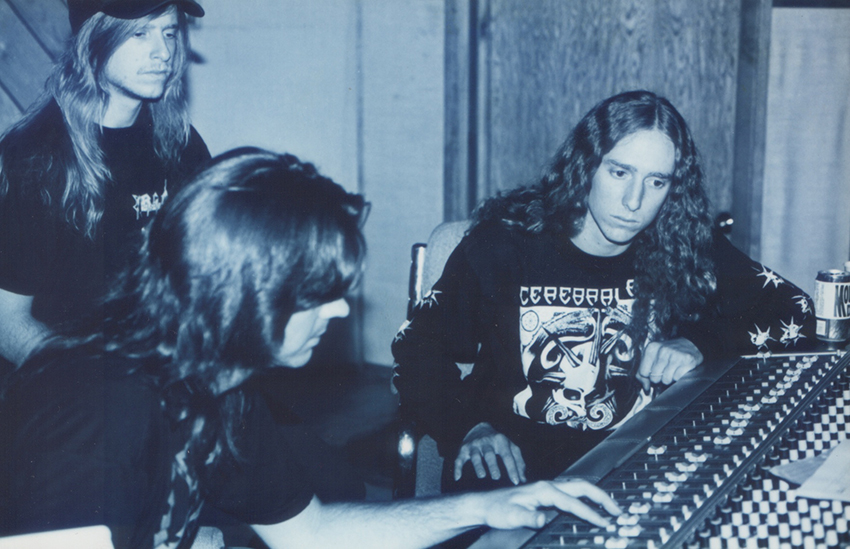
Donald Tardy: One time with Scott, John did the craziest, heaviest built-up scream thing, and when he was done with it, John’s look was so proud. He knew it sounded so good, and Scott was like, “So, did you want me to record that?” And John said, “You’re gonna die.”
Monte Connor: Something very curious about the sound of the album, the actual mix of the record and the sonics—I believe the rhythm guitar tracks on that record are recorded out of phase. A way that you can tell something’s out of phase usually is that something sounds very, very stereo, like more stereo than it should. It wasn’t until we were remastering the record in 1997 with George Marino, the mastering engineer, and he’s the one that pointed it out. Scott Burns, to this day, will deny it, because it’s the type of thing a producer’s not gonna want to admit, because it’s basically a glitch in the recording.
Watkins: They had this guy at Morrisound [Kent Smith], he would make commercial jingles and stuff. And we needed some ambient music or ambient shit behind our stuff. We wanted our record to go from the beginning of an intro into the second and first song, and all the songs kind of mesh, so it plays one continuous way. This guy is like a 40-, 50-year-old guy and he had no clue what death metal was. And I just told him, “Just think evil. Just think horror and scary movies and that kind of stuff.” And the whole time he’s doing these keyboard parts, he’s giving us these crazy, evil looks and he’s going, “Yeah, I feel it. I feel it, I feel it.” And were like, yeah, this is perfect.
How did your cover of Celtic Frost’s “Circle of the Tyrants” come about?
Peres: Donald and I were still in the studio room and I started playing the first riff off “Circle of the Tyrants,” and Donald kicked in. He knew what it was because we used to play it live, as well as other Celtic Frost songs we used to play. We didn’t know it and Scotty hit record, just playing around, and we came in the console room after we were done just playing around and Scotty said, “Check this out,” and he hit play and we said, “Oh shit, that sounds sick.” Everybody was like, “Damn dude, we should do that on the album.”
Did you ever hear from Tom G. Warrior about your cover?
John Tardy: I talked to him. We were in a hotel, down at the bar and, for some reason, he and one of the other guys in the band, they walked in and we started talking to him. He had heard the cover and did say he liked the cover. I bet he got some four or five dollars in royalties from us playing his song.
Donald Tardy: He got to buy a six-pack of beer, probably, at least.
INFECTED
Did you notice a big difference between Slowly We Rot and Cause of Death?
Murphy: Oh yeah. It was very evident. And I was very happy that I had been able to add something. And all the guys commented on it at the time. Later on, they made public comments that Allen’s [style] was theirs. And I can’t really disagree. I think I added something unique and special to Cause of Death that made that a very special record.
Connor: I think Cause of Death is by far the band’s best record. It’s definitely the most creative thing that the band has ever done. Even though Slowly We Rot has an amazing brutality and raw edge to it, I really think Cause of Death is the best of both worlds.
How did you get the artwork for Cause of Death?
Peres: It’s something we didn’t really know about, really. I personally had found some artwork we wanted to buy from Time-Life. I was in the library looking at books and stuff, and I found this piece of artwork. It was an old Civil War scene in the woods and all these ghosts of dead Civil War veterans were walking around. It was kind of creepy. We tried hard to get that piece, but Time-Life would not release it without selling it. So I basically told Monte, on a whim, I said, “Hey, do you have any artwork laying around that no one’s using yet?” He said, “Yeah, we got this piece by Michael Whelan, it’s pretty sick. Let me send it to you.”
Connor: When Sepultura was first signed and when we were recording the Beneath the Remains album, Max sent me a copy of the artwork that eventually got used on Cause of Death as the cover that Sepultura wanted for Beneath the Remains. Michael wound up sending us a book of other artwork in it besides this Obituary painting. We wound up seeing the [Beneath the Remains cover] and we wound up thinking that “Wow, this would be a better looking cover for Beneath the Remains.” So we wound up pretty much just convincing Sepultura that the skull would be a better painting for them. We ended up using the other cover as the cover for Cause of Death.
Peres: I opened up the FedEx envelope and pulled it out and it was the Cause of Death cover, and I looked at it and I was like, “Holy crap, this is our cover. I don’t care what anybody thinks…”
Watkins: As soon as I saw that eyeball, I was like, “Man, that’s different. That’s really fuckin’ different.” And it was a big discussion between us because some of us liked it and some of us were like, “You know what? I could live with it, but…” There was a big cockroach on it. We were like, maybe if you took that off, moved this here… Finally, we decided that’s the one we wanted to use.
Connor: That’s not the full painting. The other section of that cover was sold to another band, that band Demolition Hammer [for Epidemic of Violence].
Peres: Later we found out Sepultura was planning on using that artwork and none of us had a clue. I kind of felt bad in a way. It had nothing to do with us. It was Monte. Monte did it. It was really his mistake in a way by giving it to us.
Connor: It was definitely me that sent the artwork to Obituary. At the time, they didn’t know that Sepultura wanted it for Beneath the Remains. Neither band knew what was going on until the albums came out.
Donald Tardy: [Sepultura] knew it had nothing to do with us. There’s never been any bad words, and I don’t think there’s really any bad feelings ’cause it was our record label’s mistake, not necessarily band members fighting over something. I wish I would have talked to ’em about it, but obviously it was much more fun moving on and touring with each other like we did.
Connor: For years later, Igor [Cavalera] from Sepultura was upset with me, really pissed off about that whole incident because he wanted the cover of Cause of Death to be the cover of Beneath the Remains.
Peres: Later on we found out Igor had part of the thing tattooed on his arm.
As you were finishing recording the album, you took your promo photos. What do you remember about the coffin pic?
John Tardy: Not wanting to do it.
Donald Tardy: Not wanting to do it and that Scott Burns built those coffins.
John Tardy: [Scott and photographer Tim Hubbard] concocted this whole idea and we all looked at it like, “That’s the stupidest thing I ever heard in my life.” And they all worked so hard and they were so proud of it. “Just try it. Please!” And we try it and of course it was just dumb, and of course Roadrunner will use anything you give ’em.
Murphy: They looked pretty cheesy in the picture, but they looked really cheesy in person. They were like the thinnest plywood you could get, spray-painted black and tacked together. I was like, “Wow, are these things going to break if I lay in it?” We were very, very skinny kids at that time.
Donald Tardy: We were so young that we a) got talked into it, b) realized how stupid it looked and c) actually gave it to a record label thinking they might not use it. That’s what you call 18 years old.
John Tardy: Don’t fart onstage and give it to a record company, because it will be used.
Peres: I think those photos are kind of silly of us laying in ’em. Even today when I look at it, ’cause we’re all just wearing jeans and freakin’ t-shirts and freakin’ Vans tennis shoes, lying in this frickin’ coffin. It looked silly as hell. A lot of people think it’s cool. But, you know…
Watkins: I think Trevor and I took one of them home and we used it as a coffee table in our apartment.
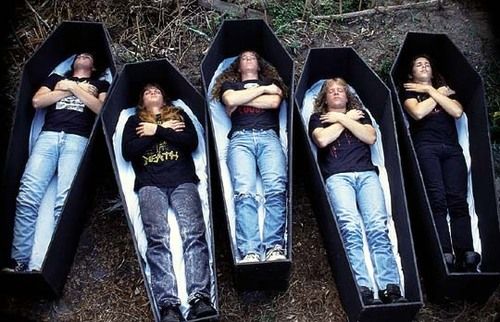
GATES TO HELL
Almost immediately after you finished recording Cause of Death, you went on the first Slowly We Rot tour with Sacred Reich and Forced Entry. What do you recall about your first national tour?
Peres: I remember even Sacred Reich, they were like “Oh, what’s this shit? A death metal band touring with us?” They were like old thrash metal guys, thinking we were gonna suck. By the middle of the tour, we had their respect. They were like hanging out with us, partying with us and loved us to death. The crowd loved us. Everywhere we played, we crushed and sold tons of merchandise.
Murphy: One day, it was at the Eagles Hall at [Milwaukee Metalfest]. I think we had been told not to do pyro, and so [Big Daddy, our roadie] was just like, “The hell with that,” gonna do it anyway. This was a place that huge ceilings. We had 30 feet to the ceiling. And we were 20 feet to any wall. This stage was huge.
Watkins: What we didn’t really calculate on was that some of the people that we brought to put it all together, some of Big Daddy’s buddies, were drunks and idiots, and they left some of the gaffer tape on top of the pipes that shot the flames up. So when Big Daddy ignited everything, everything instead of shooting up imploded down, and the stage completely blew up and stuff went flying.
Murphy: I think it knocked Donald off his drum stool. It threw wood out into the crowd, like jagged, sharp pieces of wood everywhere. I saw a piece fly over the crowd’s head and land behind the soundboard. I got shoved forward, and I thought it was just a concussion at first, but it hurt really bad. And I turned around and there was a piece of wood laying right behind me. And it was completely sharp and pointed on one end. And someone said, “That piece of wood hit you flat across your back, dude. I thought you were going down.” It hurt really bad and I was deafened, but we actually continued playing and finished the set. If that piece of wood had spun around, that sharp point certainly could have killed me.
How was your first European tour—the first official Cause of Death tour—with Morgoth and Demolition Hammer?
Donald Tardy: That was our first time in Europe. We flew the day Stevie Ray [Vaughan] died.
Murphy: I remember we had to stay an extra day, and the airline put us up in hotel rooms and gave us meal tickets at this cafeteria. And we were in line getting our food at this cafeteria, and the radio playing over the PA announced that Stevie Ray Vaughan had died in a crash after this concert in a big mountain somewhere. His helicopter had crashed. I don’t think any of us finished our food.
Donald Tardy: I thought, “Damn, I just got out of the air and Stevie just died trying to fly, and he’s been doing it for a decade and this is my first tour.” I was like, “I hope I get to live for at least as long as he did.”
Murphy: I think we just picked at [our food] and were just blown away, and our hearts were sunk to our feet and it was one of the most tasteless, bland meals that we’ve ever had.
Donald Tardy: It affected John and I, because we were some of the biggest Stevie Ray fans ever. We saw him that year, live, with Steve Vai or someone opened for him.
THE END COMPLETE
How did everyone get along on the tour?
Murphy: I was a little set apart from the other guys in that I didn’t partake in all the “party utensils.” That wasn’t my thing, and still isn’t to this day. They did enjoy quite a bit. So that put a bit of a distance between us a bit. I certainly never complained openly. At the same time I realized, hey, I’m in a metal band. And this is par for the course.
Watkins: That tour kind of showed us the demise of James. Because when we first met James, he was a really cool guy. He was outgoing. He was talking with us. We just really got along. We got on tour and we finished the record and we started doing shows, and he started coming out to us. And he would always complain about everything. I was like, “It’s gotta stop, man. We can’t handle it.” It got to the point where it embarrassed us a few times with other guys in some of the other bands, he embarrassed us. And it got to the point where we were like, “I don’t think we’ll be able to hang with this guy anymore.” He’s turned into a separate person in the band.
What do you remember about returning home from Europe?
Watkins: When I got home from that tour, I had a military duffel bag that I kept all my clothes in and all my stuff. I get to the front door of my mom’s house and she wouldn’t let me in the door. She made me put my bag in the yard. [Laughs] And she hosed me off because I stunk so bad. Because we wouldn’t shower; we were just going crazy, man.
What lead to Murphy’s departure?
Watkins: We did a U.S. tour with him, with Sepultura and Sadus; it was like immediately after that European tour with Morgoth. Right when we got home, I drove up with the guy from Roadrunner, this guy “Psycho” came to visit me. I pull into the Tardys’ parking lot and I see Allen West’s truck sitting there. I walk in and Al’s playing guitar. And I’m like, “What are you doing, Al?” And he’s like, “What do you mean, what am I doing? I’m playing my fucking guitar.” And I was like, “Killer!” And I turn around and here comes James pullin’ up in the driveway. And I was like, “Oh shit. I wonder what’s gonna happen here.” And me and the guy from Roadrunner kind of walked outside and walked around and waiting and James went in there.
John Tardy: James went and did the European shows with us and then we came home and Al just kind of hung out. It wasn’t like we never talked to Allen or he quit kind of thing; he just had what he had to do at the time.
Peres: We had never wanted Allen to leave the band, obviously. After we got back from those tours, it was ironic. Allen called us and was like, “Hey.” His baby was born and he was mentally stable and ready to jam again. Right after that, we wanted him back in the band, because he was a big part of the band at that point.
Donald Tardy: It probably sucked for James. It probably hurt him a little bit, but he had to have seen it coming, only because it was obvious to us that Allen was Obituary. He was the beginning of it and he’s been on every album with us.
Murphy: I was agitated, obviously, to show up at what I thought was going to be a rehearsal and Allen was there. I was like, “Oh, what’s going on?” And then that’s when I think it was Donald came out and told me, “We’re getting Allen back.” At that time, I think I was like, “Whatever. Let me get my stuff.”
Watkins: James walked out and said, “I’ll see you later, Frankie. I’m out.” And that was the last time I saw him.
Murphy: Definitely moving on from that band was the right thing for me and it was the right thing for them.
Watkins: It’s unfortunate because I really did think of him as the guitar player in the band. Musically, he was amazing. It fit like a glove. And we could have done some really crazy shit in the future as far as the leads, but it kind of brings us back to what Obituary was and still is, which is we’re just in-your-face death metal. And that definitely prolonged us to make The End Complete and the rest of the records we did.
Looking back at Cause of Death, what are you proudest of?
Donald Tardy: It was the album that really started kids to realize what the two words mean when they say “death metal.” With Venom and Hellhammer and Slayer back in the day, to us that was death metal. That was metal. We didn’t know what it was. So as a band we just started writing music that our heroes would probably want to write. Cause of Death was the album that really made the idea that, “You want to see a death metal record? You want to hear it? Go get Cause of Death!”
